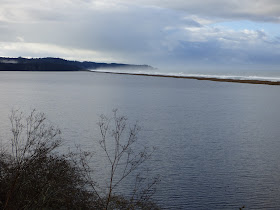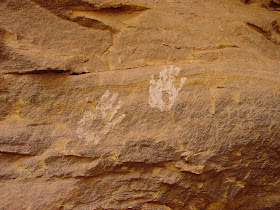 |
| House on Fire Ruin in Bear's Ears. I wasn't smart enough to catch the "fire" in the rocks at the time. |
There are a lot of pictures in this post, and I hope you will enjoy them. They are the ones most precious to me, the product of two hikes into the heart of Bear's Ears National Monument in the years before it was established as a monument by President Obama in 2016.
National monuments are a bit different than national parks or national recreational areas. Parks (and recreational areas) are established by Congress. They may preserve vast scenic landscapes like Yosemite or Grand Canyon, or may be declared because of their potential for, well, recreation (examples are Golden Gate Park in San Francisco, Oregon Dunes, or Lake Powell).
The origin of national monuments is by presidential proclamation. Under the Antiquities Act of 1906, presidents can declare monuments of areas with archaeological, historical, or scientific value that are threatened with destruction through looting, mining, logging, or urban development (some monuments are as small as single houses in big cities). They are often controversial, because somebody was to profit off the exploitation of the resource in question, but they are always federal lands that are supposed to be administered to the benefit of all citizens, not the select few. They aren't "land grabs".

Controversial or not, many monuments are eventually transformed into national parks by Congress as the representatives come to realize the value of protecting a resource (or more cynically, how the surrounding towns benefit monetarily). This happened with Grand Canyon, Zion, Olympic, Arches, Death Valley, Joshua Tree, and quite a few others. It would be unthinkable today that someone would want to eliminate national parks from our country's heritage. And that is what is so disturbing about the present administration...they are trying to eliminate protections from a series of national monuments, and invariably it is for the purpose of mining (coal and uranium) or logging, or quite seriously, to make it easier to plunder archaeological sites and rob graves.

I am trying to imagine the protests that would arise if a Civil War battleground were to be eliminated from its status as a monument so that a housing development could be constructed (it's happened). Or digging up an English Castle ruin because coal beds were underneath. Or an ancient Hebrew temple ruin being bulldozed in Israel for a shopping center to be built. These kinds of historical sites are valued by the dominant culture or majority population, and it is easy to understand why people would be upset. What's less easy to understand is why it is so much easier for some to destroy the remains of ancestral Pueblo culture in the American Southwest. The lands at Bear's Ears are held sacred by not one, but five different tribal nations, and they have tried for decades to get this monument established. A great deal of planning and negotiation went into determining the boundaries. There are around
100,000 archaeological sites within the monument, and the vast majority have never been investigated or studied in detail (most should remain undisturbed).
I have only barely begun to explore the riches of the Bear's Ears, having walked through maybe half a dozen canyons that have been carved into the plateaus within the park. These pictures were taken in two forks of a single canyon at the north end of Cedar Mesa within Bear's Ears. A single canyon of perhaps a hundred or more canyons in the monument. And these are just some of the pictures. This land is a precious treasure of sacredness and knowledge of the past.
J.R.R. Tolkien said in the forward to his Lord of the Rings trilogy that he "disliked allegory in all its forms", and I've seen some clumsy ones over the years, but I was looking at the pictographs in the picture above, and noticed how parts of the figures have been destroyed, either by vandalism or eroson (I suspect the former). I couldn't help think that this is a metaphor for what Secretary Zinke and the president are doing to Bear's Ears as they
carve it up to make it easier to mine uranium. So much history is lost when lands are not given the protection they preserve.
 |
| No, I didn't dig up this bit of what was probably a moccasin. It was already sitting out on a rock. |
Cedar Mesa (which makes up a huge part of the southern part of the monument) is a plateau that rises out of the desert above Bluff and Mexican Hat. It is more of a semi-arid landscape that is covered today by a pinyon-juniper forest, and in the highest reaches, ponderosa pine. It is desolate and lonely, crossed by a single paved highway, with not a single development or habitation. A thousand years ago, it was home for thousands of Ancestral Puebloans (once called the Anasazi), and a visit at that time would have revealed thousands of acres under cultivation for maize and beans. It was one of the most important agricultural regions in the entire southwest. Remains of villages lie scattered across the plateau and in the gulches and valleys below. As I understand it, the area once supported a population much higher than the one that exists today.

Early on, and for most of the history of the region, people lived in the open on the plateau surface. Towards the end, just before the abandonment of the region, the situation had changed and people began to construct literal fortresses in the alcoves of the sandstone canyons. One ruin I saw was simply astounding. It was built flush with the wall of the canyon and was mostly invisible, aside from a single structure (above). A closer inspection revealed seven or eight rooms hidden behind a façade (on the right side).

Even more extraordinary was a granary or additional room about fifteen or twenty feet higher up the sheer cliff. It was completely inaccessible by any means that I could see. At best, I could guess that access was possible only by placing logs into the cliff to make steps, or a large ladder, but it would be a terrifying climb in any instance. One has to wonder what had changed to make these people so scared, and so defensive? There are all kinds of clues in the ruins and hints in the oral histories of the people in the region, but no definitive answers.
The interior walls are astounding as well. Soot from years fires covers the plaster they used to fill cracks in the rocks. After eight hundred years, one can still make out the fingerprints of those who came before (above). It is an incredibly intimate connection to the past.

Every victory is fragile, every loss is catastrophic. These ruins sat undisturbed for 600-700 years before Europeans moved into the region in the 1800s and started plundering. It was the destruction of ruins like these that caused the passage of the Antiquities Act in 1906, and Bear's Ears is one of the last regions that needs to be part of the monument system. I "assume that some of them are good people" (to paraphrase the current occupant of the White House), but some the people living in the area are part of the network of grave robbers and plunderers. There have been arrests, but for the most part these "thieves of time" (as Tony Hillerman so aptly put it) steal with impunity. They feel free to threaten the overextended federal officers who are trying to patrol the lands and protect them. Some have told me personally about having mummified bodies in their garages, or described the use of heavy equipment to tear down the walls of ruins or digging pits to get at artifacts. Without adequate protection, the loss to humanity will be incalculable.

In a sense, I am preaching to the choir. When Zinke allowed comments on his proposal to gut the monument, they ran 98% to 2% in favor of preserving the monument as is. Most of those who would take the time to read this are the people who also know the importance of preserving the past.
If you can, see these places before they fall to the vandals and grave-robbers. If you aren't able to see them, work towards their preservation from a distance. Support those who are involved in the lawsuits against the president's illegal actions. Make your voices heard...
...because those who plunder these lands can't hear the voices of those lived and died here for thousands of years. Nor will those in power listen to their descendants. We only have the times we are living in to do our part to preserve the stories and artifacts of this bygone past. In so many ways it is a gift to be able to play a part in doing the right thing.
Some of the parties to the lawsuits over the national monument reductions
are included in the article found here. The clothing manufacturer Patagonia deserves credit as well. They have taken a very public stand in favor of the monuments (
information here).


















































